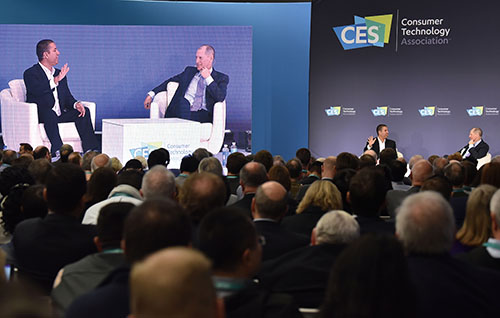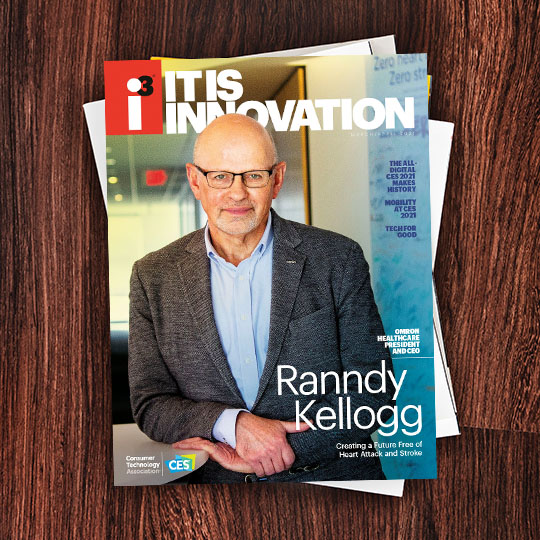
I had a pretty good idea about the Commission’s structure, personnel and policies, but one thing that surprised me was the sheer workflow specifically associated with the Chairman’s Office.
There’s a host of issues unique to the Chairman and his team: the agency’s budget, labor and employment issues, the move to a new building (which we completed), bilateral and multilateral relations with foreign counterparts, and many other tasks, none of which I’d ever had to handle in previous roles. And of course, all of these are in addition to the core functions of the job — namely, setting and executing the agency’s policy agenda. Fortunately, I had a terrific team, and plenty of coffee, alongside me!
I’m proud of our many policy accomplishments. We did much work to close the digital divide, both through market-based reforms to the Universal Service Fund and regulatory modernization to incentivize broadband deployment. We advanced U.S. leadership in 5G (including the highest-grossing and the largest spectrum auctions in history) and next-generation Wi-Fi (including quintupling the amount of mid-band spectrum available for Wi-Fi).
We promoted innovation, from low-earth orbit space constellations to streamlining the process for authorizing advanced consumer electronics. We promoted many consumer interests, from attacking unwanted robocalls to establishing a three-digit number for suicide prevention and mental health to enabling more Americans with disabilities to access communications technologies.
I’m also proud of how we transformed the FCC itself. We had an ambitious agenda, and we executed. We were by far the most productive FCC in recent history, with twice the output at our monthly meetings compared to the past few decades. We substantially increased the bipartisan nature of our decision-making compared to recent years. We instituted new transparency reforms, the most notable of which was publishing on the internet proposals and orders at least three weeks before the FCC voted on them. We established the Office of Economics and Analytics to give economists, data scientists, and others a seat at the policy-making table. And we strengthened our workforce, from setting up an Honors Engineering Program to starting an Early Career Staff Diversity Initiative to financially support student interns from underrepresented communities.
I knew going in that I would hold the gavel during the most poisonous political environment in my memory. But I didn’t expect the extent to which some would take things too far, occasionally egged on by politicians, celebrities and social media. I would not wish on anyone some of what my family and I went through over the past four years, such as death threats and racist invective, up to and including my last week in office.
I realize that some who are ideologically opposed to our work on hot-button issues may shrug it off as the consequence of an ambitious policy agenda or the price of public service. But one should think carefully about where that path takes us; the destination is not a place that reflects the America I want to see.
I believe the FCC did an excellent job ensuring that American consumers could leverage communications networks when the pandemic caused a massive disruption to our country. We instituted the Keep Americans Connected Pledge, under which consumers would not face service disconnections or late fees and could access any Wi-Fi hotspots. Almost 800 broadband and telephone providers took the Pledge, and many went above and beyond it.
We waived certain rules to enable low-income consumers, schools and others to maintain access to FCC-administered benefits. We granted emergency access to spectrum, enabling a wireless carrier to double its speeds in urban markets and fixed wireless companies to extend access in rural markets. We implemented the COVID-19 Telehealth Program, under which we directed $200 million in funding from the CARES Act to 539 applicants located everywhere from New York City to Navajo Nation.
We worked with the U.S. Department of Education to raise awareness for state governments and local school districts of the $16 billion made available in the CARES Act that could be used for education technology. We urged Congress proactively and repeatedly to give the agency more authority and funding to help ensure connectivity during the pandemic. And we took every possible step to ensure that our own workforce would be safe, including being one of the first federal agencies (if not the first) to move to mandatory telework.
I do wish Congress had granted us authority to establish a Remote Learning Initiative, as I had requested in a letter I sent to them before deliberations on what became the CARES Act. But overall, I’m proud of the work we did; especially considering the scale of social disruption, our initiatives and public-private partnerships did much to ensure that consumers by and large could count on communications services.
Whether that is continued investment in broadband technologies or creation of new devices that make consumers’ lives better, the industry is poised to deliver critical value in the time ahead.Ajit Pai Former Chairman of the Federal Communications Commission
Technology has been indispensable to American consumers during the pandemic. Among other things, it’s enabled us to telework, do day-to-day tasks like grocery purchases online, visit via telehealth with health care providers, do remote learning, and of course stay in touch with loved ones.
Since the pandemic’s inception in the U.S., I’ve often heard some variant of “if this had happened 10 or 20 years ago, I don’t know how we would have been able to function.” Going forward, I hope the tech industry continues to innovate and deliver solutions to consumers.
Whether that is continued investment in broadband technologies or creation of new devices that make consumers’ lives better, the industry is poised to deliver critical value in the time ahead.
Two different points: one on strategy, one on tactics. First, during the transition in late 2016 and early 2017 and early in my chairmanship, my team and I made a conscious decision that we would swing for the fences, so to speak. We wanted to make a big and positive difference across the board, from broadband to broadcast.
Second, tactics. We purposely elevated career staff (as opposed to outside hires with connections) into leadership positions in our bureaus and offices and let them shine. That ended up ensuring that all of us had a vested interest in accomplishing our agenda. I also made it a personal priority to value our staff. This was the right thing to do as a co-worker, and it also stemmed from the years I spent as a staffer.
Many of them have told me since I left the Commission that they appreciated things like publicly mentioning retirements, hosting thank-you events, and (in a first) listing in my own statements on meeting items, the names of every staffer who worked on them. Speaking of meetings, we decided to dramatically increase the work we did at our monthly meetings. When I was a commissioner, we would typically consider only two or three matters at those meetings. We increased that significantly to six on average, with the peak coming in November 2018. For that month, which we called “Space Month,” the agenda included over a dozen items.
Finally, we wanted to structure the agenda so we got as much done as possible by the fall of 2020. Despite some unexpected events — including the pandemic, which forced us into a telework posture in March 2020 — we were able to do that.
Because of these decisions on strategy and tactics, I can honestly say that there is nothing major that I wish we had gotten done. I’m proud that we accomplished all we did with the time we were given — and that we did it together.
Visiting CES was one of the highlights of my time at the FCC. Ever since I became a Commissioner in 2012, I treasured walking the show floor and seeing the future of innovation in the present. I particularly loved exploring Eureka Park. A few years back, one serendipitous visit to the booth of a Toronto-based startup led to an informative meeting with that startup in their headquarters.
On a personal note, I’ve always enjoyed the serendipity of having lived for several years next door — literally next door — to CTA Executive Vice President Karen Chupka. She has done a fantastic job for many years organizing CES — one of the largest trade shows in the world — and I’m honored to call her a friend.
Visiting last year was a great experience. The energy of the show as I walked around was palpable. And I tremendously enjoyed my conversation with you Gary. You deserve a lot of credit for your long-standing advocacy for innovation.
In terms of what I saw that made an impression, one thing that stood out was a television that could display a different program depending on where you were sitting or standing. Given that I’m typically the last in line in our household when it comes to picking what to watch, I could benefit from that!
At the outset, I want to make clear that whoever the next permanent chair is and whatever his or her agenda might be, I hope he or she succeeds. The FCC’s success will be America’s success, and I will be rooting for my successor and the Commission overall.
Going forward, I would expect closing the digital divide to remain the agency’s top priority; the pandemic has only underscored the importance of connectivity for all. I also hope the agency will continue to execute on our successful 5G FAST Plan, a strategy for U.S. leadership in wireless innovation, which included taking the steps necessary to hold two more important mid-band spectrum auctions this year. And I expect the FCC to maintain a focus on emerging technologies that will be increasingly important in communications, such as artificial intelligence, machine learning, network virtualization (specifically, open radio access network technologies), and quantum computing.
Finally, to the extent that Congress examines legislation on certain topics, such as whether and how to regulate certain internet platforms, I would expect the next FCC to have some involvement in that conversation.
First, I would encourage my successor to think purposefully about what he or she wants to get done and then work diligently to get it done.
Second, I would leverage the talent of the FCC’s amazing career staff and honor their efforts every step of the way. They are dedicated, smart public servants who love their country, and their efforts are vital to accomplishing one’s agenda.
Third, I would try as much as possible to tend to things that matter most: family, friends and non-FCC activities that are personally meaningful. Leading the agency is quite a challenging job, and those things will help maintain perspective.
I haven’t yet made any concrete plans. I just finished a four-year sprint and still need to catch my breath! But I’m hopeful that the next adventure will be as rewarding as my time at the FCC. Whatever comes next, I will always be grateful to have had the chance to serve my country as Chairman of the FCC.
It gives me great pride to be the first Indian-American and Asian-American to serve in this position. And I marvel that this opportunity arose just one generation after my parents came to the United States from India with little more than eight dollars, a transistor radio and a belief in the American Dream. As we often say in our family, “only in America.”

I3, the flagship magazine from the Consumer Technology Association (CTA)®, focuses on innovation in technology, policy and business as well as the entrepreneurs, industry leaders and startups that grow the consumer technology industry. Subscriptions to i3 are available free to qualified participants in the consumer electronics industry.